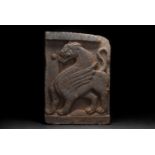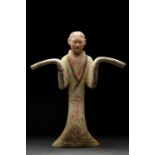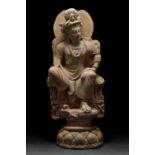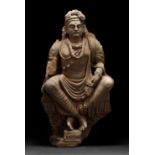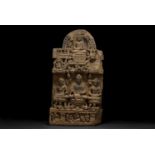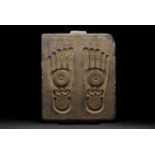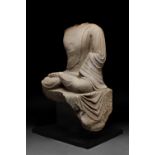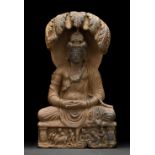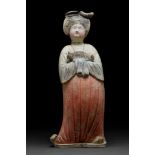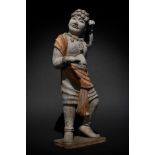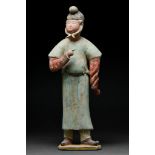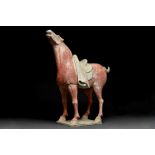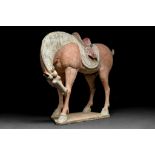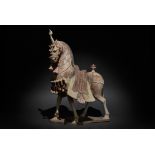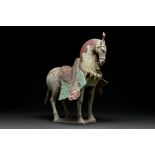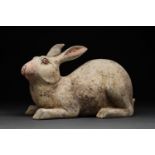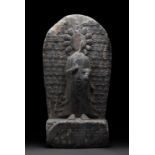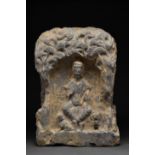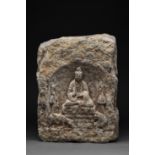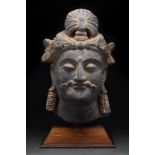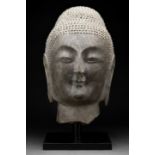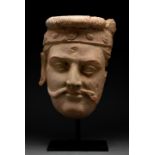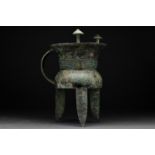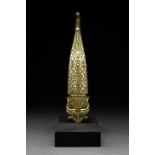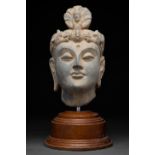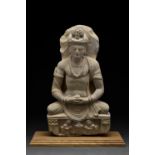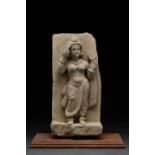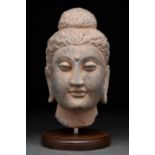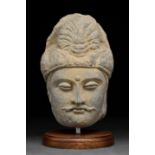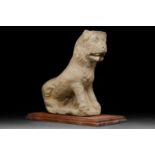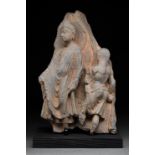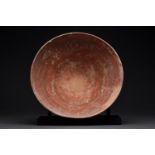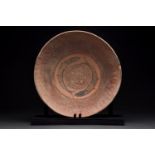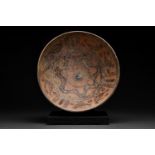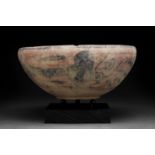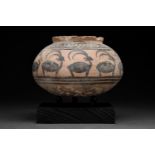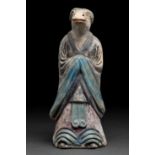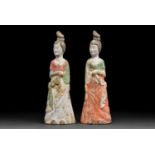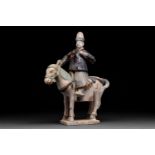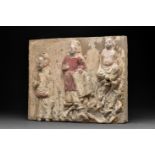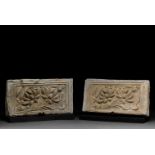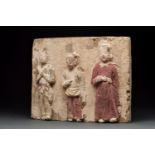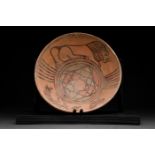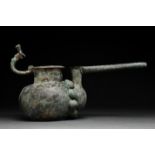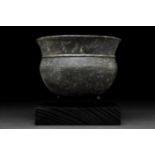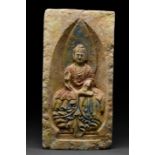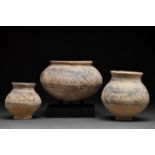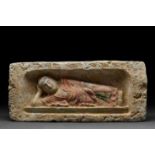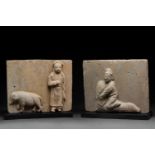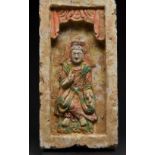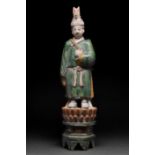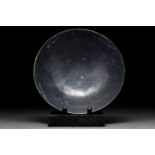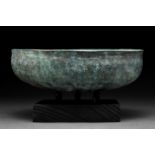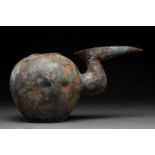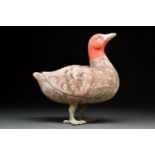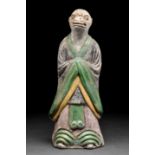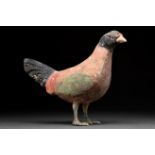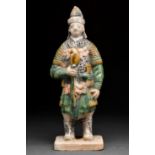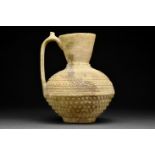Refine your search
Estimate
Category
- Arms, Armour & Militaria (108)
- Greek, Roman, Egyptian & Other Antiquities (68)
- Jewellery (41)
- Sculpture (35)
- Chinese Works of Art (32)
- Glassware (11)
- Ceramics (5)
- Coins (5)
- Collectables (4)
- Porcelain (4)
- Islamic Works of Art (3)
- Stamps (3)
- Books & Periodicals (2)
- Metalware (2)
- Scientific Instruments (2)
- Taxidermy & Natural History (2)
- Kitchenalia (1)
- Textiles (1)
- Vintage Fashion (1)
- List
- Grid
A subscription to the Price Guide is required to view results for auctions ten days or older. Click here for more information
Ca. 202 BC–220 AD. Han Dynasty. A beautiful rectangular stone relief depicting a dragon in left profile with a high-arched tail. A short beard ext...
Ca. 202 BC–220 AD. Han Dynasty. A well-modelled, pottery standing female dancer with arms stretched out in opposite directions, the hands well hid...
Ca. 202 BC–220 AD. Han Dynasty. A hollow-formed terracotta cream-coloured rhinoceros shown standing four-square with a well-cast head with two hor...
Ca. 300–400 AD. A seated figure of the Bodhisattva Maitreya, the Buddha who is believed to be incarnated in the future for the salvation of mankin...
Ca. 400–500 AD. Gandharan. A grey chlorite-schist statue of the Bodhisattva Maitreya seated in the so-called “European pose” The face is well prop...
Ca. 100–300 AD. Gandharan. A schist narrative relief depicting sequential scenes from the life of the Buddha. The most prominent scene depicts the...
BUDDHAPADMA PANEL
Ca. 100–200 AD. A grey chlorite-schist rectangular panel, carved with the impressed footprints of the Buddha. Each footprint is et within its own ...
Ca. 618–907 AD. Chinese Tang Dynasty. A beautiful marble statue of a seated bodhisattva depicted wearing voluminous robes elegantly draped over hi...
Ca. 200–300 AD. A grey chlorite-schist statue of Prince Siddhartha Gautama meditating beneath the Jambu tree. The figure is shown with the body he...
Ca. 618–907 AD. Chinese Tang Dynasty. This elegant court lady stands on a flat base. Her hands are held close to her body and they support a small...
Ca. 618–907. Tang Dynasty. This curly-haired young foreigner is shown in the movement of dance with his left arm raised and the left reaching forw...
Ca. 618–907. Tang Dynasty. A beautifully modelled terracotta male attendant standing on a flat base. The figure is shown with head turned in a res...
Ca. 618–907 AD. Chinese Tang Dynasty. A beautiful terracotta horse standing upon a flat rectangular base with a long neck artistically turned up. ...
Ca. 618–907 AD. Chinese Tang Dynasty. A beautiful terracotta horse standing upon a flat rectangular base with his mouth touching the left front le...
Ca. 386–534 AD. Northern Wei Dynasty. A finely hollow-moulded terracotta horse statuette modelled standing foursquare on a rectangular base, the h...
Ca. 386–534 AD. Northern Wei Dynasty. A finely hollow-moulded terracotta horse statuette modeLled standing foursquare on a rectangular base, the h...
Ca. 206 BC–220 AD. Han Dynasty. A hollow-formed terracotta rabbit figurine with creme pelt, coral-pink pigmentation on the nose and ears, and red ...
Ca. 618–907 AD. Tang Dynasty. A beautiful stele depicting a standing Buddha in high relief on a plinth. The ovoidal-shaped stele behind the main B...
Ca. 581–618 AD. Chinese Sui Dynasty. A four sided stele depicting Buddhist scenes. Each side contains a niche surrounded by lotus motifs. The lotu...
Ca. 581–618 AD. Chinese Sui Dynasty. A four-sided stele depicting Buddhist scenes. On two opposite sides a Buddha sits in fine flowing robes upon ...
Ca. 200–400 AD. A schist stone head of a bodhisattva Maitreya. He is presented with the adornments of a North Indian prince, with elegant hair and...
Ca. 618–907 AD. Tang Dynasty. A beautiful limestone (?) head of a Buddha with a plump face, elegantly curved almond-shaped eyes beneath sharply de...
Ca. 200–400 AD. Gandharan. A finely modelled terracotta head of a bodhisattva. A bodhisattva was originally conceived as Gautama on his path to en...
Ca. 1300–1200 BC. Shang dynasty. A beautiful bronze jia tripod vessel comprising a flaring rim, inward sloping neck, flaring shoulder and flat bot...
Ca. 475–221 BC. Warring States period. An S-shaped curved gilded bronze belt hook surmounted by a small dragon head with a long slender neck that ...
Ca. 200–400 AD. Gandharan. A schist stone head of a bodhisattva on a modern wooden stand. He is presented with the adornments of a North Indian pr...
GANDHARAN SEATED BODHISATTVA
Ca. 200–400 AD. Gandharan. A schist stone statue of a bodhisattva. He is seated cross-legged on a decorated plinth, richly dressed in the fine gar...
Ca. 200–400 AD. Gandharan. A schist stone relief of a courtesan, or ‘ganika’. The woman is richly adorned, showing her high status. Her hair flows...
Ca. 200–400 AD. Gandharan. A schist stone head of a Buddha on a modern stand. He is shown with thick lips and full cheeks, long pendulous earlobe,...
Ca. 200–400 AD. Gandharan. A schist stone head of a bodhisattva on a modern wooden stand. He is presented as a North Indian prince, with elegant h...
GANDHARAN SCHIST STONE LION
Ca. 100-500 AD. Gandharan. A stucco lion on a modern wooden plinth. The lion is seated, rising from the base with its front paws erect. It has a d...
Ca. 200–400 AD. Gandharan. A schist stone relief of a Buddha with an attendant. The Buddha is shown here standing in a stance full of motion with ...
Ca. 3000–2000 BC Indus Valley Civilisation. A shallow terracotta bowl in a deep amber colour standing on a ring foot. The interior is decorated wi...
Ca. 3000–2000 BC. Indus Valley Civilisation. A shallow terracotta bowl in a deep amber colour standing on a ring foot. The interior is decorated w...
Ca. 3000–2000 BC. Indus Valley civilisation. A shallow terracotta bowl in a deep amber colour standing on a ring foot. The interior is decorated w...
Ca. 3000–2000 BC. Indus Valley civilisation. A deep terracotta bowl in amber colour standing on a ring foot. The exterior is decorated with panels...
Ca. 3000–2000 BC. Indus Valley civilisation. An interesting terracotta storage jar, amber coloured. The exterior is decorated with black painted r...
Ca. 1368–1644 AD. Ming dynasty. An elaborate terracotta zodiac figure in a court dress or shenyi consisting of a long waistcoat tied at the waist ...
Ca. 618–907 AD. Tang dynasty. A finely modelled pair of terracotta figures of female court ladies. Both are depicted standing and attentive, weari...
Ca. 1368–1644 AD. Ming dynasty. An extremely fine moulded terracotta figure of a male rider shown on horseback. The cream-coloured horse is depict...
Ca. 960–1279 AD. Song dynasty. A beautiful tile that may have been part of the decoration of an aristocratic tomb with three male attendants in hi...
Ca. 960–1279 AD. Song dynasty. A fine pair of terracotta bricks decorated with high-relief floral motifs set within rectangular frames. The back o...
Ca. 960–1279 AD. Song dynasty. A beautiful tile that may have been part of the decoration of an aristocratic tomb with three male attendants in hi...
Ca. 3000–2000 BC. Indus Valley Civilisation. A shallow terracotta bowl in a deep amber colour standing on a ring foot. The interior is decorated w...
Ca. 1100–700 BC. Western Asiatic. A bronze vessel with a short neck, globular body, ring foot and L-shaped, elongated spout decorated with a band ...
ACHAEMENID BRONZE BOWL
Ca. 500–330 BC. Achaemenid. Beautiful deep shouldered bronze bowl, hammered from a single thick piece of sheet. The bowl has a globular body, a ri...
Ca. 386–534 AD. Northern Wei Dynasty. A rectangular ceramic brick featuring a seated Buddha with a plump face, elegantly curved almond-shaped eyes...
Ca. 3000–2000 BC. Indus Valley Civilisation. Beautiful set of three terracotta jars. The smallest one is standing on a ring foot. The interior is ...
Ca. 386–534 AD. Northern Wei Dynasty. A painted brick featuring a reclining Buddha figure placed within a rectangular recess. Buddha, who supports...
Ca. 960–1279 AD. Song dynasty. Two beautiful tiles that may have been part of the decoration of an aristocratic tomb. The tile on the right-hand s...
Ca. 386–534/535 AD. Northern Wei Dynasty. A terracotta tile featuring a beautiful depiction of a seated Buddha wearing garments whose red and gree...
Ca. 1368–1644 AD. Ming Dynasty. An elaborate male figure with beautifully glazed pigment. The man is standing with his feet apart on a large lotus...
WESTERN ASIATIC BRONZE BOWL
Ca. 800–500 BC. Western Asiatic. An outstanding Western Asiatic / Achaemenid bronze wine bowl with a flaring rim; a lustrous bronze surface persis...
WESTERN ASIATIC BRONZE BOWL
Ca. 800–500 BC. Western Asiatic. An outstanding Western Asiatic / Achaemenid bronze wine bowl with a slightly flaring rim; a beautiful patina enha...
Ca. 1100–700 BC. Western Asiatic. Bronze vessel with globular body, ring foot and short L-shaped, elongated spout. This gorgeous piece attests to ...
Ca. 202 BC–220 AD. Han dynasty. A beautiful and rare Chinese Han dynasty pottery duck with bronze legs. The duck is standing on its detailed bronz...
Ca. 1368–1644 AD. Ming Dynasty. An elaborate terracotta zodiac figure in a court dress or shenyi consisting of a long waistcoat tied at the waist ...
Ca. 206 BC–220 AD. Han dynasty. A beautiful terracotta bird with a light red body, black head and tail, green wings and legs. Historical texts ind...
Ca. 1368–1644 AD. Ming Dynasty. An elaborate male figure with beautifully glazed pigment. The man is standing with his feet apart and dressed in a...
Ca. 1100–1300 AD. Seljuk. A beautiful cream-coloured unglazed jug with the body moulded in two hemispherical halves, a funnel-shaped spout, a high...

